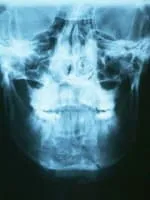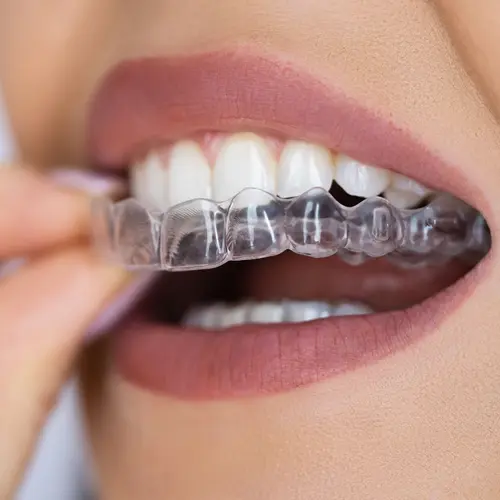This X-ray shows a broken jaw. The dark angular line near the bottom right of the jaw is the fracture. Photo courtesy of Lisa Chan, MD, Department of Emergency Medicine, University of Arizona.

What Is a Broken or Dislocated Jaw?
A broken jaw (or mandibular fracture) is injury to the mandible, or jawbone. It’s a common type of facial fracture; only the nose and the cheekbone are broken more often.
The U-shaped mandible is the largest and main bone of the lower part of the face. There are two chief areas of the mandible bone: the “body” -- the chin out to the jaw angle -- and the rami, the two upward branches.
The jawbone connects to the skull at the temporomandibular joints, better known as the TMJs, on either side of your head in front of your ears. Ligaments hold the bone in place, and muscles let your jaw open and close. When your jawbone comes out of its normal position in one or both of the TMJs, that’s a dislocation.
What Are Causes of a Broken Jaw?
A broken jaw is the 10th-most commonly fractured bone in the human body. Fractures (breaks in the bone) are generally the result of a direct force or trauma to the jawbone. The most common causes are:
- Motor vehicle accidents
- Assaults
- Sports-related injuries
- Falls
- Workplace accidents
Men are about three times more likely than women to sustain a broken jaw. Those ages 20 to 29 are the group most commonly affected.
A dislocation can also be caused by trauma to the face. But usually it happens when you open your mouth too wide, like while taking a bite of something, yawning, or during a dental procedure.
What Are Symptoms of a Broken Jaw?
A jaw fracture happens after a trauma. If your jaw is broken:
- You’ll have jaw pain.
- You may feel that your teeth do not fit together correctly (this is called a malocclusion).
- You may be unable to open your jaw all the way or have problems speaking.
- You may notice swelling or bruising of the jaw.
- Your chin or lower lip may be numb because of damage to a nerve that runs through the mandible.
- Inside the mouth, you may see bleeding.
- Teeth may be loose or missing.
- There might also be bruising under the tongue or even a cut in the ear canal due to movement backward of the broken jawbone.
If your jaw is dislocated:
- You’ll have jaw pain.
- You may not be able to close your mouth or open it very wide.
- Your jaw may be twisted to one side
- Your bite may not line up correctly.
- You may have trouble speaking or swallowing.
When Should You Get Medical Care?
If you have symptoms, you need medical attention. This kind of injury is best checked out at a hospital. Your doctor may advise you to go to an emergency department. Remember, if you are the one who is injured, you should not be driving. Have someone take you to the emergency department.
Put any broken or lost teeth in cold milk, salt water, or saliva and take them with you.
A potential but serious consequence of jaw fractures is a problem breathing due to loss of support to the tongue. Any signs of breathing problems need to be addressed immediately by calling 911.
You should also get emergency help if there’s uncontrolled bleeding, signs of shock, or if there’s the possibility of a head or spine injury.
How Is a Broken Jaw Diagnosed?
A doctor will give you a physical exam and may order X-rays. Blood tests usually are not necessary.
The physical examination includes a general inspection of your face for obvious deformity, bruising, or swelling. The doctor will also look at your TMJ (temporomandibular joint), and check to see if there’s nerve or vascular problems. The next step is feeling the jawbone through the skin.
The doctor will check the movement of the mandible. Once the external exam is complete, the doctor will check inside your mouth. You’ll be asked to bite down, and your doctor will look at how your teeth align.
The doctor will check the jawbone for stability. With the straight blade test, the doctor may place a tongue blade (tongue depressor, a flat wooden stick) between your teeth and evaluate whether you can hold the blade in place.
The best screening film is the panoramic X-ray, completely around the jaw. This type of X-ray may not be available in smaller hospitals, so other views may be substituted. If the first X-rays don’t show anything conclusive. Your doctor may order a CT scan if they think you have a broken jaw.
How Is a Broken Jaw Treated?
If there is any question that you may have a broken jaw, you need to be checked by a doctor or a dentist specializing in oral surgery.
Self-care at home
If you think your jaw is broken, see a doctor. Apply ice to the jaw to help control the swelling on your way to be seen by the doctor. Try not to move your jaw. Wrap a bandage under your chin and over the top of your head to immobilize it if necessary. Sometimes you will need a paper cup to catch the drool or to spit blood into on the trip to the doctor or emergency department.
Medical treatment
Many people who have jaw pain will not have a jaw fracture and will be treated with pain medications and instructions to eat a soft diet and to follow up with their doctor.
- Further evaluation is required if you have a broken jaw. Many fractures of the jawbone are associated with gum problems or tissue damage and should be considered open fractures. They will be treated with antibiotics.
- You may receive a tetanus shot.
- Pain will be addressed and managed effectively.
- Many mandible fractures are stable, and the only treatment required is wiring the upper and lower teeth together. This will most commonly be performed by an oral and maxillofacial surgeon.
- More unstable fractures often require surgery. Surgical methods using plates across the fracture site may allow you to have normal motion of the mandible and to eat shortly after surgery.
What Are Treatments for a Dislocated Jaw?
Manual repositioning. Your doctor or dentist will first move your jaw back into place. They put their thumbs inside your mouth on your back bottom teeth and hold the bottom of your jaw with their fingers. Then they manipulate your jaw down and backward until it pops into place. You may need pain medicine or sedation for the procedure.
Barton bandage. They will often wrap a bandage under your jaw and around the back of your head to keep your jaw in place while it heals.
Surgery. If your jaw gets dislocated often, you might consider surgery to tighten the ligaments that support your jaw.
What Can You Expect for Broken Jaw Recovery?
Many jaw fractures need surgery. Because of that, you may need to follow up with a surgeon. Take antibiotics as instructed and follow all diet recommendations.
With treatment, a broken jaw will typically heal in a month or two.
While your dislocated jaw is healing, you should try not to open your mouth very wide for several weeks.
How Can a Broken Jaw Be Prevented?
Because the most common causes of jaw fractures are motor vehicle accidents and assaults, the best prevention is to drive carefully and avoid situations that could turn violent. You can also wear protective devices while taking part in sports.
What’s the Outlook After a Broken Jaw?
Depending on the nature and location of the fracture, it may have to be fixed with surgery. Some fractures do not require surgery and are managed best with diet changes and pain control. Some people may need to be admitted to the hospital based on their injury.

